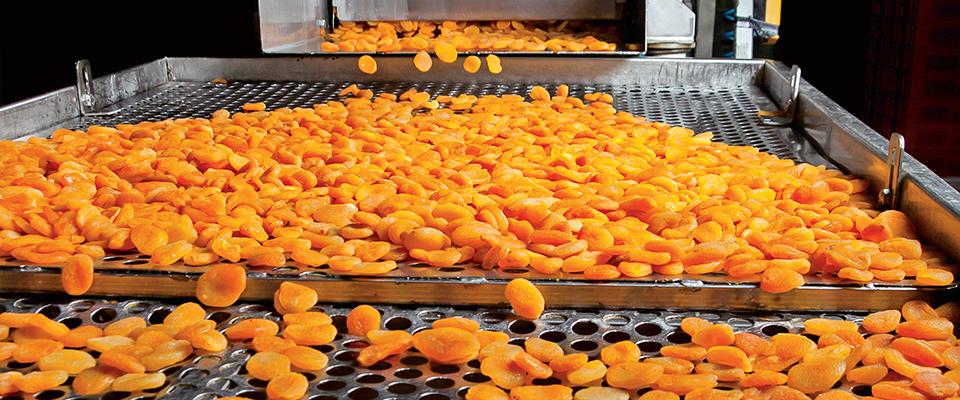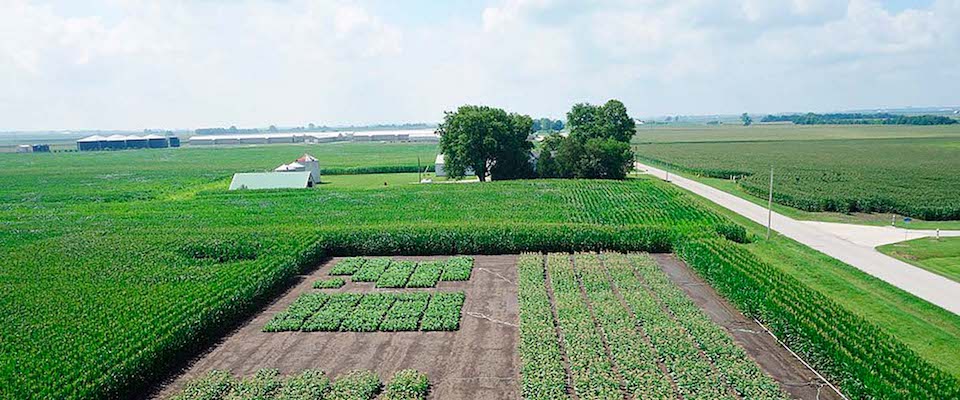At a laboratory on the side of Interstate 80 in Albany, Fatima Alleyne sits at a computer, trying to solve a major food dilemma.
Food processing is the third largest energy user in California, the top agricultural state in the nation. Plants that process food, beverages, and tobacco emit more than 1.6 million metric tons of greenhouse gases a year, according to the California Environmental Protection Agency’s Air Resources Board. The U.S. Department of Agriculture doesn’t particularly like that. In fact, in a perfect world, the government would like to see processors use little to no electricity and natural gas—just resources from Mother Nature.
It’s a tall order. Maybe even an impossible one.
But in January the USDA hired Alleyne, a 35-year-old post-doctorate researcher from UC Berkeley’s Department of Materials Science and Engineering, to see if it’s even remotely doable.
Mostly known as a regulatory agency, the USDA has a team of 30 scientists cloistered in a big building on Buchanan Street, to focus on making agriculture and food production as sustainable as possible. The group, called the Processed Foods Research Unit, is one of only a handful that the USDA has dotted around the nation. Given that agriculture in California is a $45 billion business, producing 400 commodities and half of the fruits, nuts, and vegetables grown in this country, it makes sense to have one of the units here.
The grounds include greenhouses, test kitchens, and exhibits that showcase foodstuffs they have created: dried fruit roll-ups, nut bars, tortillas made solely of vegetables. The research team’s mission is to make all sorts of specialty crops—fruit, vegetables, nuts, legumes, and grains—easier and more cost effective to grow, but most importantly, more marketable. This includes coming up with ways to improve the nutrition, function, look, and feel, of food. They also study the biochemical reasons why food tastes good or bad, and how to keep it from losing flavor during processing. Their other objective is to make popular foods that are low-cost for both the consumer and the environment.
The bottom line: The government wants Americans to eat more fruits and vegetables for all the obvious reasons—to combat obesity, make people healthy, help farmers sell their goods, and boost American agriculture.
The USDA is ready for the final step: building a machine that can store solar thermal power so that food processors can use it round-the-clock, during peak harvest times.
The team’s expertise is available to anyone in the food industry, be it a small family farmer or a mega food processor, says Tara McHugh, the unit’s research leader. Often, the unit works side-by-side with a university or a company to develop new technology or original food items.
“We’re trying to solve problems [in ways] that will not only benefit the consumer and the producer, but help the economy and the environment,” McHugh says.
So in the Buchanan Street laboratory, researchers are looking at such esoteric questions as: Why do some olives taste like cow dung? What is the compound that makes basmati rice have such a pleasant toasty flavor? How do we put vitamin D back into mushrooms?
And now: How do we help food processors stop being so wasteful with energy?
The plan is simple—the USDA wants to harness the sun. But finding a way to make it work 24/7, that won’t change the flavor or texture of the product and still be cost effective, is not so simple. That’s where Alleyne comes in, even though she admittedly knows nothing about food.
“For a long time, I literally thought soup came in a can,” she jokes. “Of course that changed when I moved to California from New York. Cooking? My husband is the cook in our family.”
But the USDA doesn’t care about her lack of food knowledge. In that corner, the agency’s scientists have her back. They are counting on her background to find the best materials for the job.
“There are very few materials scientists in the USDA across the country,” says Rebecca Milczarek, a research agricultural engineer who is heading up the government solar project. After four years of research, the USDA is ready to move to the final step: building a machine that can store solar thermal power so that food processors can use it round-the-clock, during peak harvest times. That is the job with which Alleyne has been tasked.
Unlike photovoltaic solar (panels on the roofs of houses that turn sunlight directly into electricity), solar thermal energy is made by heating a liquid or gas, such as water, oil, salts, air, nitrogen, or helium, with concentrated sunlight. Photovoltaic solar is only effective during daylight hours, and storing electricity to run a plant is not all that efficient. Thermal energy is easily stored. The trick for Alleyne is making the energy’s storage vessel as well as the liquid source safe for food—without sucking out all of its nutrients.
Solar thermal technology has been used since the middle 1970s. Swimming pools have been heated by low-temperature collectors, using flat plates. Homes and commercial businesses have been heated and cooled by medium-level collectors. And high-temperature collectors that capture sunlight using mirrors or lenses can actually power large industries.
The world’s largest solar thermal plant, Ivanpah, was constructed by Bechtel in the Mojave Desert and is operated by NRG Energy. Last year it began delivering power to PG&E and Southern California Edison and is expected to one day supply enough carbon-free energy for 140,000 homes. The project, developed by BrightSource Energy and Bechtel, cost $2.2 billion.
Using solar thermal on the scale of Ivanpah is fairly new. But throughout the years, scientists have experimented with the technology in efforts to make groundwater contaminated with pathogens safe. Costa Rica has used solar thermal to dry coffee beans. India has used it to fuel stoves and cook meals, and in California, a Modesto food processor has used the technology to make steam for powering the company’s manufacturing equipment. A number of other food manufacturers in California have deployed it for various purposes—Frito-Lay has used it to heat frying oil.
Not only will solar thermal cut greenhouse gas emissions—it could save shoppers at the cash register.
But the bulk of processors in the Golden State still consume more than 590 million therms of natural gas and over 3,700 million kilowatt-hours of electricity a year—10 to 20 percent of their operating costs. At this point, mainstream energy continues to be more cost effective and reliable for processors that need to work after dark, during the harvest, when manufacturers are in a race against time to keep their produce and nuts from spoiling.
But McHugh and Milczarek both say that relying on mainstream energy sources is not sustainable. They believe that they can make solar thermal power work even after the sun goes down, reduce the food industry’s carbon footprint and power bills, and ultimately bring down the cost of food. Especially inefficient, they say, is the current method of drying and blanching fruit, vegetables, and nuts. It represents a large chunk of the industry’s energy cost. There are about 230 fruit and vegetable processors in California responsible for processing 16 to 18 million tons of products a year.
“It is urgently needed to develop economically viable, sustainable alternative drying and blanching methods with high energy efficiency and with no water usage,” says McHugh.
For now, the USDA is starting with a solar thermal dryer, with plans to eventually take on blanching, and later, canning, pasteurizing, and basic cooking.
Some processors, including many raisin companies, are already using nature’s methods. They simply let their fruit dry on the vine or in the sun. But a good many dry their produce by burning natural gas to pump heated air into a large room, effectively turning the space into a giant oven. That often gets the job done in 24 hours or less.
But it comes at a high price, both in money and in damage to the environment. Operators of the more than 3,000 dryers and dehydrators in the Central Valley found that their energy bills accounted for 60 percent of production costs, according to the California Institute of Food and Agricultural Research. That’s why in 2006, UC Davis’s Innovation Hub, which focuses on agri-food systems technologies, identified solar thermal as one of the three top research and development priorities for the state’s food industry.
“The produce dehydration sector is facing particularly severe energy-linked pressures,” the organization wrote in its Technology Roadmap: Energy Efficiency in California’s Food Industry report. “The dehydration process is often inefficient, employing outdated technologies.”
Already, dried fruit from Turkey and Greece are quickly taking over the American market. Food makers there get huge government subsidies, and labor is cheaper, says Rob Neenan, president and CEO of the California League of Food Processors, a trade group.
“If something makes sense dollarwise, the industry here would be very interested,” he predicts, adding that there are 40 California food processors that would have an incentive to use solar thermal power. Those companies will exceed the state’s carbon dioxide emission limits under the 2006 Global Warming Solutions Act’s cap-and-trade program and be financially penalized.
Not only will solar thermal cut greenhouse gas emissions, but Milczarek believes that by replacing current methods, the drying industry could cut its production costs by nearly half. This could save shoppers at the cash register.
“I think it’s unlikely that a processor would pass on 100 percent of the cost savings to the consumer,” she says. “However, it’s fair to say that the cost of the final dried product has the potential to be reduced by more than half, if solar thermal energy is used for all the process air heating.”
Milczarek thinks the team is a couple of years away from developing a 24-hour solar thermal dryer that could reach the needed temperature of 140 degrees and would work for small- to medium-sized processors with one to two tons of produce or nuts. The team has already come up with part of the solution. It plans to use disodium phosphate heptahydrate—a salt that can store heat as it goes from a solid to a liquid—to expedite the drying process.
Now all Alleyne has to do is find the right food-grade materials to build the dryer.
A 20-tray dryer, capable of holding five pounds of wet fruit, could retail for a couple thousand dollars. It could be of particular use to small growers selling dried fruit at farmers’ markets or farm stands.
“You can’t just use any material,” she says. “It’s actually quite limited. It can’t be toxic, it needs to be something that won’t alter the food’s nutritional value, and the product still has to taste and look good.”
Her background is in ceramics, but for this project she is considering glass or acrylic, transparent materials that can transmit light from the sun. For the structure of the drying box, Alleyne is thinking of using either aluminum or stainless steel, but she’s worried about keeping the weight down. She wants the contraption to be portable, food safe, and for it to store as much sunlight as possible to maximize energy efficiency.
Since the beginning of the year, she has been running various formulas through a special computer program. She figures she could build a 20-tray dryer, capable of holding five pounds of wet fruit, for a retail price of a couple thousand dollars. Of course, the price would increase with the size of the dryer, but not by much, predicts Alleyne.
The unit could be of particular use to small growers selling dried fruit at farmers’ markets or farm stands. The USDA also hopes the dryer finds a niche with home food-manufacturing businesses operating under California’s one-year-old cottage food law.
As Alleyne plugs numbers into her computer program, she laughs. “I just never thought of foods and materials science [together].”
Frankly, she says, four months ago she didn’t know much at all about what the USDA did, let alone that the government agency embarked on endeavors such as the solar thermal project. Before seeing the posting on a government job board, she thought she was headed to Sandia National Laboratories to work on ways to safely store decommissioned nuclear weapons.
“My ultimate goal was to make a positive impact on my country,” she says.
When Milczarek explained to her that the USDA wanted to use solar thermal to dry crops overnight, Alleyne thought, “I don’t have any background in agriculture, but this I can do. It isn’t too far-fetched or abstract.
“What could be more positive for my country than reducing California’s carbon footprint, being creative in utilizing the natural resources we have? Especially because I have four kids and I want them to live in a safe world, an environmentally conscious world. I want them to breathe easier.”
Stacy Finz is a former reporter and editor for the San Francisco Chronicle. Her first novel, Going Home, is due out in October.
From the Summer 2014 Apocalypse issue of California.




















